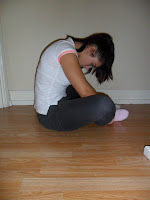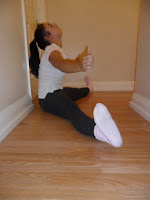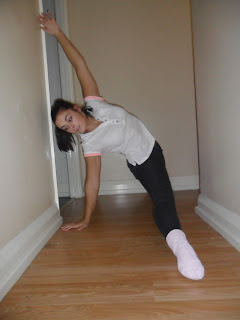I feel that I have improved in my very first goals that I set myself. I have overall gained confidence in ballet and I can feel my that my dancing technique in ballet has technically emended. I have discovered that if I try my hardest in the studio, I generally gain a better understanding of how to execute this certain technique and then I feel a part of the class. I no longer feel like I am not good enough for this technique and I can use my strengths to cover up things that I am unsure on. I now ask the teacher questions on certain movements if I am hesitant to what I should be doing, whereas when I started this year I would have asked either one of the girls or I would have just got confused and performed the movements incorrectly. I will continue to increase my potential of ballet and I will practise inside and outside of studio time.
Analysing myself in all technique classes, I have noticed that I use every bone (metatarsal, tarsal and phalangees) in my feet when dancing and I don't struggle with performing foot work phrases anymore. It has become clearer to me that when you relax certain sections of the feet into the movement it is easier and looks more pleasing than not using the floor and moving sharp to the next position instead of being smooth. Using a theraband and a tin helps to feel this movement through my feet.
I have improved in my presence to when I dance in technique due to practising more and incorporating in various sessions outside of class time. This has also given me a deeper insight to the dance world and has made me determined to reach my set goals and targets.
I have recognised from the beginning that I didn't use my breath the way I should have when dancing. Now this comes naturally as I feel like it helps to improve my movements further than normal and I feel better in myself as I can feel my muscles working.
I feel like I have experienced more things this year with other dance companies and practitioners. This has given me a greater insight into what different practitioners look for and analyse and speaking to directors has helped me with my solo ideas and choreographing altogether. I really enjoyed working with Charlotte Vincent as she shocked us and criticised our work without worrying how we felt afterwards as she was just being honest. It made me feel like I was back at gymnastics again as I was getting criticised in the same sort of ways and I felt comfortable with this kind of analysing and editing technique. I will continue to use the Liz Lerman technique when analysing my piece and other works because I feel that personally it help the choreographer/director and also the performers to improve in their work.
I will continue blogging as I feel that it is a very useful tool to help self criticise my dancing, and when I recognise myself what my weaknesses and strengths are I am then able to adjust and improve overall.
I have also lost over a stone since I began this blog and this will help with my future career in dance and gymnastics; gone from 63kg to 56kg.
Dance Choreography Advanced Contemporary
"Dance isn't a form, it's a way of life!"
Fexibility...

Using my flexibility will help my dance flow better and will help in deepening my movements.
Monday, 21 November 2011
Sunday, 20 November 2011
Working hard, showing my efforts.
In Graham and Cunningham technique today with Rebekah, we realised that she was going to take notes for our assessment on how we are doing in class. This didn't really throw any of the class off at all, it improved most people and their dancing altogether.
The beginning Graham foorwork really works all of the muscles throughout the body, and I feel like I have improved at this a lot. This sequence consists of:
Sequence 1:
Sequence 2:
Sequence 3:
We then performed the sequences in 1st position which involves spirals, curves and high releases. This is then performed in 2nd position which involves a change in direction and balancing partly on the floor.
You have previously seen me perform this sequence and here I have mixed two different sequences together to include a range of movement and see if I can perform to my best. I feel that I could execute my movements more and give a sense of presence to the rest of the class, to show my performing side.
If I perform the sequence with effort and energy and i fall over that is better than holding back on movements as it shows that I am attacking the phrase set.
The beginning Graham foorwork really works all of the muscles throughout the body, and I feel like I have improved at this a lot. This sequence consists of:
- Over-curves in 1st, parallel and 2nd.
- Bouncing in an over-curve in 1st, 2nd and parallel.
- Releasing the middle back (in a curve), to an over-curve, to releasing the back (straight line), to sitting back onto sitzbones; in 1st, 2nd and parallel.
- Brushes in parallel position to falling backwards, arching back and leading with the head to lying on the floor. Then tucking in tight and returning to the starting position again.
- Curving over the legs in parallel. Flexing the feet, to bending knees, to releasing the back straight, and curving back over again.
Sequence 1:
Sequence 2:
Sequence 3:
Sequence 4:
Sequence 5:
We then performed the sequences in 1st position which involves spirals, curves and high releases. This is then performed in 2nd position which involves a change in direction and balancing partly on the floor.
You can't see properly (as it looks like I am opening the door) but I am lifting up and out of my sitzbones to lengthen and twist the spine, creating a spiral.
 |
Here you can see that I am lifting up and out of my sitzbones but I have a slight arch in my back showing that I am leaning forwards slightly; I need to sit backwards more.
In this sequence I am always trying to think about initiating my turn out by my hamstrings pushing from underneath my tail bone, forwards and up. I usually get told about my legs rolling in when in 2nd sitting position (straddle) as I have always been trained in gymnastics to do this. This is one of my main targets in Graham technique.
"The image of human thought in Graham was heavy, organic, brooding and altogether nineteenth century, in Cunningham, it is permutational, correlational, strategic, exact, rarefied, and airy." R. Copeland. (2004) 'Merce Cunningham: The Modernizing of Modern Dance'. Pg. 191. New York; London. I feel that there are some correlations between Graham and Cunningham in the way in execute the material. I think that they are both very creative and both include the body in strong ways, using the anatomy to portray simplicity as well as complex movements.
We perform another sequence that is one of my favourites:
This is a feel good sequence, as I can feel the definite twist in the spine and how much I can reach up and out of my tailbone feeling a sense of gravity and freedom at the same time. I feel like I am able to 'show off' in this sequence as it feels really nice and every part of the body feels like it has a chance to open and spread out. I feel like this sequence also tests strength because if I do this sequence correctly it does hurt as you can feel the muscles burning, whereas I know from previously watching this class that some pupils just go through the movements without putting maximum effort in. The dish hold part of the sequence is a good way to tell whether people are in the correct positions or not and whether they are working to their full potential.
I use a lot of breath when performing Graham and Cunningham technique as I feel it not only helps get you through the piece, but it deepens everything and almost but you in the correct positions without even trying.
"The 'attitude about movement' that Dunn refers to is another index of intellegence. Certain dancers gravitated away from other companies and toward Cunningham precisely because his work struck them as 'intelligent'. The intelligence of his movement is, first and foremost, a quality inherent in the movement itself." R. Copeland. (2004) 'Merce Cunningham: The Modernizing of Modern Dance'. Pg. 191. New York; London. This is how I feel when I do cunningham technique; having a specific attitude to the way I am dancing. I try to perform this technique with the precision that it has been created by, whilst also trying to move through the anatomical bodily stucture.
One of my biggest mistakes, other than my turn out in 2nd, is sticking my ribs out and arching of the back. Here you can see that my bottom is sticking out and is raised off of the floor, helping my legs to roll inwards; this initiate my back to bend and therefore push my rib cage outwards. I recognise this in class now as I can feel my movements in incorrect positions.
This is a better position as you can see that I am putting my weight into the floor through my tail bone to help ground my central position. This in turn, helps to turn out my legs and improve my basic stance. You can witness my ribs alignment in the photograph above which is helping to give a straight line through my back sending the energy up and out of the crown of the head.
In these videos, you can see that I am performing with precision. Most of these movements are lengthened (moving to balance) to help control myself so that the sequence runs smooth. You can see that my left side (viewers right) is more controlled and altogether more presice than my right (viewers left). This is because i find it easier to control when I am not performing on my most flexible side. I have improved at being able to control this and I will further this in my career of dance.
I feel that altogether I can improve at this sequence and make it look effortless.
If I perform the sequence with effort and energy and i fall over that is better than holding back on movements as it shows that I am attacking the phrase set.
Copland states; "Much the same can be said of Doris Humphrey - as well as of Duncan, Fuller and Graham: It is obvious that they are intelligent; and, yet, their work is not "about" being intelligent. For example, one would be reluctant to describe most pre-Cunningham modern dance as "brainy." (To be sure, "brainy" is an adjective rarely applied to modern dance before the advent of Cunningham and the Judson era.) Deborah Jowitt recently referred to the Cunningham company's "high IQ limbs." It's difficult to imagine her praising Graham's dancers in the same way - even though their bodies are just as technically powered."
Confidence is key!
In cunningham technique we perform a sequence that is more like release; here I perform to my best. When I am in class I think about what I did in the previous class and think about what corrections the teacher gave us so that I can perform them straight away.
This sequence consists of:
This sequence consists of:
- Plie's.
- Tilts.
- Spins/turns.
- Balances/holds.
- Lunges.
- Kicks.
- Shifts.
- Rolls.
- Spacial Awareness.
- Flexibility.
- Strength, these are all things that I am at more of an advantage on compared with the rest of the class, due to gymnastics.
- Change in dynamics.
- Making the movements juicey and fluid.
- To perform it using facial expressions and energy that shows.
- Continuous movement.
- Creating different angles.
- Making some movements unexpected (sharp turns).
- The admiration I have for the teacher's movements.
Here is a quote that illustrates the above, "Feminist - New style". Bromley. D. pg 33. Modern Dance Bodies. (2002). University of North Carolina Press, United States of America.
Saturday, 19 November 2011
Using more weighty movements, improves the movement a lot!...
Today I went into Geoff's lesson with the mental state of not being stuck in one place in the room and move about the space, as I don't want to experience my movement in the same position all of the time.
We began the session the same as normal with a slow sequence that helps to increase the stretch of the bodily parts. This is my favourite part of the sequence (below), as I can feel a counter stretch.
Stretching and reaching the leg away, relaxing the shoulders and back into the floor with a sense of being grounded. Looking towards that arm helps to increase the stretch of the back and gluteals.
Pulling the knee over further pulls the hips over and the arm follows. From this I circle my arms to the above position and back round to the below position. Creating circles with the arm improves the stretch of all of the limbs. This position above uses gravity to relax into the ground.
Pulling back from the hip to release the arm up and over. The above shows my body lengthened and stretched to the full.
The next sequence I performed includes curves, plie's, high releases and rises. I feel confident with this phrase, but I know that I can always improve on this.
We began the session the same as normal with a slow sequence that helps to increase the stretch of the bodily parts. This is my favourite part of the sequence (below), as I can feel a counter stretch.
Stretching and reaching the leg away, relaxing the shoulders and back into the floor with a sense of being grounded. Looking towards that arm helps to increase the stretch of the back and gluteals.
Pulling the knee over further pulls the hips over and the arm follows. From this I circle my arms to the above position and back round to the below position. Creating circles with the arm improves the stretch of all of the limbs. This position above uses gravity to relax into the ground.
Pulling back from the hip to release the arm up and over. The above shows my body lengthened and stretched to the full.
The next sequence I performed includes curves, plie's, high releases and rises. I feel confident with this phrase, but I know that I can always improve on this.
I performed a sequence at the bar, which includes, what I think, precision. I always think about what my body is doing in this sequence and today I could feel it. I could feel every metatarsal, and phalangees moving through the floor and I could feel my tail dropping to the floor when performing a curve. When going through retire, I could feel my hamstrings, gluteals and semitendinosus muscles working to pull my turn out forwards. You can see some of this in the video below.
I am super confident with this sequence and I try my hardest to complete it using all of the techniques taught to me. Geoff said to me that I perform this sequence superbly and he would easily give me a 2.1 as I use my technique to the full and I am doing everything asked of me, attacking the space and the phrase itself, but if I put a little bit more weight into my movements then he would give me a 1st. I did that and he told me that was spot on, so I went over it again outside of class to continue improving it (as you can see below).
Moving onto the next sequence keeping this in mind, I performed this using as much travelling as possible and using my quadriceps to push me through the space. As you can see in the video below, I was towards the right side of the room for the start of this sequence and I was slightly squashed (I moved to the middle of the room when I performed it again), this made me movements slightly smaller than normal. I still attempted to execute this fully and then began to travel away from the side of the room. I try my hardest to use the power and energy in my legs to make my sequence flow more and look aesthetically pleasing and I think that I managed to do this eventually. As you can see, there is a varied dynamic range that this can be performed in and I tried to make a few of my movements a surprise. As I like to travel in my classes you can see that there is not enough room for me to do this as I also fall into the mirror towards the end.
We began another short jumping phrase which included the use of power in the legs. This sequence was to travel as much as possible across the room. One of the things that Geoff mentioned was to use our heads with the movement, especially on the side step as he said our heads had to look at the floor to resume normal position for the 360 jump.
Subscribe to:
Comments (Atom)
















































